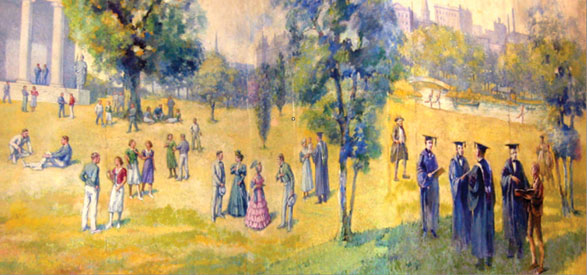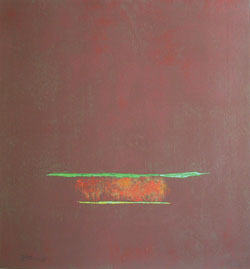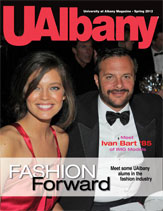
Ask Geoff
By Geoff Williams, University Archivist
Art on UAlbany’s Downtown Campus
(Part 2)
Pictured above: An idealized Van Ingen mural places the Hawley Building in Washington Park, with a gathering of the school’s founders, including Horace Mann; the first principal, David Page; and Gideon Hawley, founder of the common schools in New York.
hrough the Federal Emergency Relief Administration (FERA), and subsequently through the Works Progress Administration (WPA), William B. Van Ingen, an accomplished artist and muralist from Philadelphia, was commissioned to create murals for Hawley Hall. Van Ingen’s creations included murals for the Panama Canal Headquarters Building and the Pennsylvania Capitol building. Nothing is known about how the contract was awarded, but Van Ingen’s early conception of the project had been to fill the walls with verdure tapestries – primarily of green trees – but he soon decided the images should relate to the history of Albany, New York State and the State College for Teachers. One of his murals is an idealized image, on level ground, of the Albany and Schenectady railroad station on State Street, where the college opened in 1844. The building was actually on State Street below the Capitol building, an area so steep that the railroad quickly abandoned the building, as steam engines couldn’t pull the railcars up the hill. Horses had to be used instead to pull the cars into the station.
Van Ingen, who had a studio in New York City at the time, collaborated with NYSCT President Abram Brubacher on the choice of themes for the Hawley Murals. The artist sought photos or etchings of the subjects he was portraying, and Brubacher frequently traveled to New York to monitor his progress. Occasionally, there were creative differences: Brubacher overruled Van Ingen’s intent to portray the first airplane flight from Albany to New York City, insisting instead on a depiction of the Civilian Conservation Corps (CCC). The college president won the argument, but the switch also provided Van Ingen a fine opportunity to portray his green trees in the work. (In Milne 200, David Lithgow did paint a mural of Glenn Curtiss’ 1910 Albany-to-New York flight.)
Below, left: If the Milne Conference Room isn’t being used, have a look at this work by Theodore Stamos, one of the original Abstract Expressionist artists working in New York City in the 1940s and ’50s. Below, right: Another mural depicts the World War I Student Army Training Corps, which was stationed at the college.


With Brubacher’s approval, Van Ingen sketched his ideas on 17-foot-by-4-foot canvas sheets with a total width of 250 feet, but most of the actual brushwork was done by his assistant, John E. Jackson, a noted magazine illustrator. The Works Progress Administration (WPA) paid the artists $2.50 a day. (Images of the murals may be viewed online.)
In the 1990s, the University Art Museum began displaying works from its collections of contemporary art, previously kept in storage, on the walls of University buildings. While I knew there was some contemporary art on the downtown campus, I was surprised to learn that there are 81 pieces from the University’s art collection exhibited downtown. Some of that art, such as Alen MacWeeney’s “Selected Images of Ireland,” a collection of large-format color photographs loaned to the University, is located in the Edith Tanenbaum Rudolf Room (Husted 110). The Arthur Levitt Room (Page 120) contains items from Gov. Nelson Rockefeller’s collection, including a piece by his son, Michael. Much of the art, however, is displayed in corridors (Draper Hall, second floor; Husted Hall, entrance lobby; Richardson Hall, first floor; Milne Hall, first and second floors) and is accessible to the public whenever the downtown campus is open.
All of the buildings, except Hawley, have elevators and are handicapped accessible. In Hawley, all the art is on the first floor and can be accessed by elevator from Draper Hall. Keep in mind that the conference rooms are often in use at noontime and during the evenings and may be unavailable for public access at those times.
- UAlbany Magazine
Spring 2012 - Cover Story
- Features
- Departments
- The Carillon
- Past Issues
-
Print Edition

Spring '12, PDF (8 MB)





